PhD Dissertation by Michael Bycroft
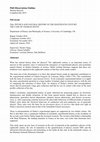
PhD Dissertation, University of Cambridge, 2013
What has natural history done for physics? The eighteenth century is an important source of answe... more What has natural history done for physics? The eighteenth century is an important source of answers to this question, since it witnessed the emergence of experimental physics and systematic natural history as distinct branches of science. Much existing literature suggests that these two traditions were opposed in the eighteenth century or that they rarely made contact. The main aim of this dissertation is to show that natural history made an important contribution to the experimental method of the French scientist Charles-François de Cisternay Dufay (1698–1739). This contribution took the form of systematic experimental history. To do systematic experimental history is to apply the same experimental operation to a large number of animal, plant or mineral species, with the aim of comparing the outcomes of these trials. An analysis of Dufay’s articles and correspondence shows that he possessed a large gem collection and that he was in contact with some of the most prolific collectors of his day. His systematic experimental history of gems informed his pioneering papers on electricity, luminescence and double refraction. In this form natural history helped him to discover new phenomena, generalise known phenomena, optimise known phenomena, and discern taxonomic rules, ie. rules expressing contrasts between the observable behaviour of different kinds of material. Dufay’s rules about the electrical behaviour of conductors and non-conductors are of particular interest. These rules were the basis for an absorption theory of electrics that sheds new light on Dufay’s electrical research and on that of his immediate French successors. These reinterpretations of Dufay’s experimental papers are supported by two further claims. The first is that there was a continuous tradition of systematic experimental history at the Académie Royale des sciences in the seventy years before Dufay began his electrical research. The second is that Dufay’s relationship with René Réaumur, the leading naturalist in France at the time, was richer than historians have supposed. This study opens up new lines of research on the role of materials in the qualitative physics of the eighteenth century, the role of naturalists in the quantification of physics around 1800, and the interaction between physics and mineralogy at the Jardin du Roi and, in the nineteenth century, at the Muséum national d’histoire naturelle.
Selected talks by Michael Bycroft

Existing histories of French physics in the eighteenth century are dominated by the Académie Roya... more Existing histories of French physics in the eighteenth century are dominated by the Académie Royale des Sciences and by the changing relationship between experiment and mathematics. This talk draws attention to a different institution--the Jardin du Roi--and to a different relationship--between experimental physics and mineralogy. From the 1720s to the 1780s the Jardin was the centre of a programme of experimental research on the optical, thermal and electrical properties of minerals that involved some of the leading scientists of the day. The members of this tradition included individuals who are usually thought of as physicists or astronomers (such as Charles Dufay and Alexis-Marie de Rochon), others who are usually thought of as naturalists (such as Louis-Jean-Marie Daubenton and Georges Buffon), and two who are rarely thought of at all (Etienne-Dutour de Salvert and Mathurin-Jacques Brisson). This tradition of “minéralogistes-physiciens” did not disappear in 1793, when the Jardin du Roi became the Muséum National d'Histoire Naturelle. Instead it flourished in the research of René-Just Haüy and, later, in a professorial dynasty begun by Antoine-César Becquerel. A focus on mineral physics at the Jardin and the Muséum reveals unexpected continuities between pre- and post-Revolutionary science in France.

Precious stones were widely studied by naturalists, experimenters, and natural philosophers in ea... more Precious stones were widely studied by naturalists, experimenters, and natural philosophers in early modern Europe. Yet historians of early modern science have written much less about gems than they have about related kinds such as minerals, fossils and crystals. In this talk I argue that the notion of 'pierre précieuse' had a meaningful role in mineral classification in France well into the eighteenth century. In other words, precious stones survived as a natural kind long after the decline of the literary genre devoted to them (the lapidary). I go on to describe two ways in which early modern mineral schemes reflected the interaction between naturalists on the one hand and jewellers and travellers on the other. Jewellers were partly responsible for the early modern shift from colour to hardness as the dominant criterion for classifying minerals. And it was in the seventeenth and eighteenth centuries that naturalists began to make systematic use of 'oriental' and 'occidental' as taxonomic terms for gems.

Historians have long fancied that there were important methodological differences between the Roy... more Historians have long fancied that there were important methodological differences between the Royal Society of London and the Paris Académie des Sciences in the early decades of their existence. In this paper I present a new contrast, one that hinges on the relationship between collectors and experimenters. Both of the institutions in question housed both collectors and experimenters, but only in Paris did the leading experimenters carry out systematic experiments on collections of plants and minerals. There were no English equivalents of the experiments on plants carried by Claude Bourdelin in the seventeenth century, nor of the experiments on minerals carried out by René Réaumur and Charles Dufay (both prolific collectors) in the early decades of the eighteenth century. I explain this contrast by appeal to the ideas of Francis Bacon and Isaac Newton and the special relationship between the Académie des Sciences and the Jardin du Roi.

The career of the French experimenter Charles Dufay (1698-1739) illustrates three features of ear... more The career of the French experimenter Charles Dufay (1698-1739) illustrates three features of early modern translations of how-to knowledge. Firstly, translations changed not only the translated text but also the translator. Dufay's translation of Filippo Buonanni's “Trattoto sopra la vernice” (1720) was one of his earliest scientific projects, and it had a major effect on his later career. It eased his entry into the Parisien Académie Royale des Sciences in 1723; it also introduced him to materials (such as gold leaf and dyestuffs) and practices (such as the importance of chance events in experimental research) that reappeared in his mature research on electricity and textile dyes. Secondly, the recovery of ancient practices went hand-in-hand with the discovery of foreign practices. In his youth Dufay used his father’s extensive library to study decorative arts practiced by the ancients; in his mature years he used the resources of the French East India Company to codify the Indian art of printing on cotton. Thirdly, the translation of words overlapped with, and sometimes relied upon, the “translation” of units, materials and experiments. Buonanni’s text was an exercise in import substitution, a search for a European equivalent of Chinese varnish or “chiaram.” Dufay’s translation of the text overlapped with his search for French substitutes for Buonanni’s materials, his attempts to replicate Buonanni’s experiments, and his search for the French equivalents of English weights and measures. Similar points hold for Dufay’s translations of writings on electricity by Francis Hauksbee and Stephen Gray. In that case, there are discrepancies between Dufay’s translations and the English originals that betray his distinctive view of electrical conductors and non-conductors.

In what ways can we talk about an "Orientalisation" of luxury? Why for a long time were Oriental ... more In what ways can we talk about an "Orientalisation" of luxury? Why for a long time were Oriental goods seem as luxurious in Europe? In this talk I answer these two questions with respect to French gemology in the seventeenth and eighteenth centuries. I focus on the textual tradition of natural histories of gems running from the Gemmarum et lapidum historia (1609) of Anselmus Boetius de Boodt to the Traité de minéralogie (1801) of René-Just Haüy. This tradition is a promising case study because the texts therein reached a growing audience of amateur collections and because the authors of these texts were deeply concerned with preciousness and the Orient. I argue that from c. 1600 these authors made increasing use of the term "Orient" to classify gems, evaluate gems, and to refer to their geographical locality. This development may be explained by the growing trade in gems between Europe and the East; the emergence of new criteria for evaluating gems, and especially the replacement of colour by hardness as the dominant criterion; and the association that emerged in the eighteenth century between fake gems (many of which were made by adding artificial colours to rock crystal) and European gems (which were increasingly seen as coloured rock crystal).

Which stones are precious? In early modern France, this question was central to the textual tradi... more Which stones are precious? In early modern France, this question was central to the textual tradition that I shall call "gemology" and that included texts by Anselm Boethius de Boodt (1609), Robert de Berquen (1661), Antoine-Joseph Dezallier d'Argenville (1742), Georges Buffon (1783-8), and René-Just Haüy (1801). In the first half of the talk I argue that these texts formed a coherent tradition, ie. all five authors recognised gems as a respectable subject of scientific inquiry, and there was a surprising degree of continuity in the way they defined this category and in the way the ranked and classified the objects in this category. Next I argue that counterfeit gems had two roles in early modern gemology: as analogies that shed light on the origin and properties of real gems; and as fakes that yielded to new kinds of test involving hardness, electricity, and double refraction. In other words, early gemmologists aimed not just to exploit artifice (as per the voluminous historiography on the crafts in the scientific revolution) but also to expose artifice. Throughout the talk I pay special attention to the role of jewelers (joailliers) in the evolution of early gemology.

Charles Dufay (1698–1739) is known to historians of science as the director of the Jardin du Roi ... more Charles Dufay (1698–1739) is known to historians of science as the director of the Jardin du Roi in Paris and the author of eight pioneering papers on static electricity. Less well-known is his interest in painting and the decorative arts. He collected ancient paintings, studied varnishes and gilding techniques, and was associated with several important figures in the world of rococo art, including the sculptor Robert Le Lorrain, the art collector Cardinal de Rohan, the art dealer Edme-François Gersaint, and the popular writer Antoine-Joseph Dezallier d'Argenville. Dufay's interests in science and art came together in his experimental research on precious and semi-precious stones. He built up a large collection of gems that he used both to study physical phenomena–such as light and electricity–and to develop new furnishings for bourgeois households–such as engraved stones and marble fire-places. By focusing on gems we get a clearer view of the links between science and art in the France of Louis XV.

To do systematic experimental history is to carry out the same experimental operation on each ite... more To do systematic experimental history is to carry out the same experimental operation on each item in a collection of plants, animals or minerals. This important early modern practice may be illustrated by the systematic experimental history of gems of Charles Dufay (1698-1739). Dufay is known to historians as the teacher of Jean-Antoine Nollet, one of the most famous practitioners of experimental physics in Europe in his day. Dufay is also known as the director of the Jardin du Roi, one of most important sites of natural history in France in the eighteenth century. These two strands of Dufay's career came together in his studies of precious and semi-precious stones. Dufay was a keen collector who used his wealth and connections to acquire many samples of marble, agate, rock crystal, emerald, diamond, and other pricey minerals. He was a node in a network that included the naturalists René Réaumur and Hans Sloane, the writer Antoine-Joseph Dezallier d'Argenville, the auctioneer Edme-François Gersaint, and other key players in French natural history in the period. Dufay deployed his gems in experiments on electricity, phosphorescence, double refraction, and the artificial coloration of stones. He used his collection to discover new phenomena, generalise known phenomena, and discern new laws. His systematic experimental history of gems is a vivid instance of one way in which French experimenters married natural history and natural philosophy in the eighteenth century.

Little is known about the contribution of natural history to the emergence of experimental physic... more Little is known about the contribution of natural history to the emergence of experimental physics after c. 1700. A good place to look for connections between the two disciplines is France in the first three-quarters of the eighteenth century. During this period Frenchmen such as Georges Buffon and Jean-Antoine Nollet played key roles in the definition and dissemination of both natural history and experimental physics. This talk surveys the role of natural history--understood as the collection, description and classification of plants, animals and minerals--in the growth of the most visible branch of experimental physics at the time, electricity. One role for natural history in this domain was to throw up curious phenomena (such as the electric fish) that were then subjected to the rigour of experimental analysis. But natural history was also a *source* of experimental rigour. This is clearest in the work of Charles Dufay, whose systematic style of experimentation owed much to his immersion in the culture of curiosity of early eighteenth-century Paris. Dufay used a wide range of carefully chosen minerals to show the generality of the electric virtue, examine its laws, and amplify its effects. Four of Dufay's notable successors--Nollet, Jacques-Mathurin Brisson, Louis-Guillaume le Monnier--carried out research in natural history before turning to electricity, and their experimental physics bears the stamp of their naturalist training. This survey draws attention to a person (René Réaumur), an institution (the Jardin des Plantes), and a discipline (mineralogy) that deserve greater prominence in histories of French experimental physics.
We know a lot about natural history, and about experimental physics, as they were practiced in ei... more We know a lot about natural history, and about experimental physics, as they were practiced in eighteenth-century France. We know much less about the role of natural history in the emergence and quantification of experimental physics in this period. This talk focuses on studies of double refraction carried out by successive directors of the Jardin du Roi in Paris. Charles Dufay is most well-known for his papers on electricity, but his experimental research on both electricity and double refraction owed much to his involvement with fashionable mineral collectors in 1730s Paris. At the other end of the century, Georges Buffon used double refraction to classify minerals in his Histoire Naturelle des Minéraux (1783-88). Finally, Buffon's research fed back into la physique expérimentale through his assistant, the astronomer and instrument-maker Alexis-Marie de Rochon.

One thesis about eighteenth-century science is that it killed off wonders from serious empirical ... more One thesis about eighteenth-century science is that it killed off wonders from serious empirical inquiry. The second is that it placed great weight on experimental spectacles. How can these theses be reconciled, given that they offer very different timetables (different by about 75 years) for the disappearance of bizarre, anomalous and striking phenomena from elite experimental practice in Europe? I will try to answer this question in an important case: Charles Dufay's memoirs on electricity. These eight memoirs are crucial to the wonder thesis because historians have taken Dufay's work on phosphorescence as emblematic of the Enlightenment disdain for wonders. They are also relevant to the spectacle thesis since other historians take Dufay's topic--electricity--as emblematic of the eighteenth century love of experimental spectacle. I argue, against the wonder thesis, that far from disdaining wonders Dufay found them valuable for epistemic reasons. And I argue, against the spectacle thesis, that Dufay found spectacles *only* epistemically valuable--he was not primarily interested in them for theatrical, political or theological reasons. On a more positive note, Dufay's electrical memoirs extend the spectacle thesis insofar as they show the value of spectacular experiments among serious researchers such as Dufay (and not just among public lecturers). And they support the wonder thesis insofar as Dufay valued wonders only as a means and *not* as an end of inquiry. Hence the Dufay case shows one way in which the wonder thesis and the spectacle thesis might be partially reconciled.
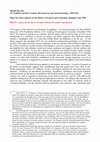
“The neglect of this subject by psychologists is appalling.” So said psychologist Joy Paul Guilf... more “The neglect of this subject by psychologists is appalling.” So said psychologist Joy Paul Guilford during his 1950 Presidential address to the American Psychological Association. The subject in question was creativity, and Guilford’s protest was so effective that in 1975 a leading psychologist could say that it represented a “paradigmic shift” to rival Binet's development of the IQ test. Guilford’s contribution to that research is well documented by psychologists, both for its intrinsic merit and its historical significance. But these internal accounts do not show the extent to which Guilford’s work was part of a movement: a unified and self-conscious effort among psychologists to study creativity and to use the results to help solve social problems. In fact, creativity research at this time was prolific, self-aware, had a strong institutional background, had close links with the world outside academia, and drew together a diverse range of approaches to the study of creativity. To show this I draw on articles and books by Guilford and other psychologists from the time, published proceedings from conferences on creativity, and (for the popular side of the movement) Applied Imagination, a widely read book written by the entrepreneur Alex Fackney Osborn. As for Guilford himself, the significance of his 1950 address has been exaggerated in internal accounts of the movement. The address was decisive for creativity research, but for the existence of that research rather than its methodology. This can be seen by contrasting the work of Guilford with that of other major psychologists of the era, such as the humanist psychologist Frank Barron.

When scientists build models and use instruments, they often give multiple lines of evidence to s... more When scientists build models and use instruments, they often give multiple lines of evidence to support their conclusions. This strategy, which I follow Michael Weisberg in calling robustness analysis (RA), has a long history in philosophy of science and a conspicuous place in everyday reasoning. It has also been used recently to support other projects in the philosophy of science. Two examples are: attempts to defend science against social constructionism (Sylvia Culp, for example, in a biological context) and attempts to downplay the role of theory in scientific practice (such as Ian Hacking's in his book Representing and Intervening). In addition, RA is a popular among philosophers of model-making: most famously, the biologist Richard Levin gave a short but influential endorsement of RA in a 1966 paper. The aim of this talk is to clarify the differences between the use of RA in the two cases of instruments and models. One result is a note of caution about the strength of RA in the case of instruments. But the main result is an account of why (despite the caution) RA is still a more powerful method in instrument use than in model building. Along the way I argue that previous attempts to give such an account are inadequate.
Papers by Michael Bycroft

De toutes les branches de la physique expérimentale au dix-huitième siècle, c'est l'électricité q... more De toutes les branches de la physique expérimentale au dix-huitième siècle, c'est l'électricité qui a connu le progrès le plus rapide et la popularité la plus répandue. Ce domaine si étonnant, “où le merveilleux se trouve à chaque pas,” fut aussi le sujet d'une grande controverse entre les partisans du Français Jean-Antoine Nollet et ceux de l'Américain Benjamin Franklin. Dutour se trouva au centre de ce débat comme l'un des partisans les plus fervents de la théorie de Nollet, qui fut à la fois son professeur, son correspondant, et son fournisseur d'instruments de physique. Il faut dire que Dutour et Nollet ne se sortirent pas très bien de ce conflit: le système Nollet nous paraît aujourd'hui aussi naïf que faux. Cependant, le projet Nollet-Dutour revêt un intérêt: avec leurs raisonnements plausibles et leurs expériences frappantes, ces deux savants mirent en évidence des faiblesses inattendues d'une théorie (celle de Franklin) qu'on considère comme l'ancêtre de la théorie vraie. Un autre thème de ce chapitre est que Dutour ne fut pas simplement le porte-parole de son célèbre maître. Il commença ses expériences sur l'électricité avant de rencontrer le système Nollet; il ajouta ses propres preuves à ce système; et il fit des recherches intéressantes sur des sujets qui en étaient indépendants.
Les recherches de Dutour sur l'électricité se déroulèrent en trois phases. En 1744 il commença sur ce phénomène des expériences qu'il raconta de temps en temps dans ses lettres à Nollet. La deuxième phase consiste en deux papiers parus en 1750 et 1755 résumant ses recherches des années 1740 et y ajoutant quelques nouvelles expériences; dans ses mémoires Dutour fit parfois usage du système Nollet, dont il avait appris les détails par une lettre de son auteur en 1745. Un troisième mémoire de 1755 marque le début de la dernière phase qui allait durer jusqu'à la mort de Nollet en 1770. Pendant cette période, et surtout entre 1755 et 1760, Dutour s'allia avec Nollet pour défendre son système contre Franklin et les autres partisans de “l'électricité en moins.”

Etienne-François Dutour de Salvert: un physicien auvergnat du XVIIIe siècle, ed. Pierre Crépel et Jean Ehrard, 2014
Pendant les années 1786-8, Etienne-François Dutour de Salvert fut quantité d'expériences et d'obs... more Pendant les années 1786-8, Etienne-François Dutour de Salvert fut quantité d'expériences et d'observations sur les propriétés optiques d'une pierre qu'il a nommée le cristal d'Islande ou le spath d'Islande. Dutour ne mena pas à bien ces recherches avant sa mort en 1789, et aucune d'entre elles n'a été publiée. Néanmoins elles représentent une enquête cohérente sur une pierre à laquelle s'intéressaient deux des savants français les plus connus de l'époque, à savoir Georges Buffon et René-Just Haüy. De plus, en étudiant cette pierre Dutour ne se limita pas à la propriété optique, la double réfraction, pour laquelle elle est connue parmi les physiciens. En effet, ses recherches sur cette propriété étaient étroitement liées à tout un éventail d'autres sujets que Dutour avaient déjà abordés lors des quarante dernières années de sa vie. Il s'agit non seulement de sujets dans le domaine de l'optique (notamment la décomposition de la lumière) mais aussi du magnétisme, de la capillarité, de la structure des crystaux, et de l'origine des pierres. En plus ces manuscrits sur le cristal d'Islande nous fournissent un aperçu de sa façon de travailler. Parmi eux on trouve des agendas, des listes d'écrits scrupuleusement cotées, des résumés de livres de grands savants comme Buffon, et de nombreux brouillons qui mettent en évidence le chemin tortueux que Dutour suivit en rassemblant, en précisant, et en perfectionnant ses idées. Ce chapitre commence par une histoire brève de l'étude du spath d'Islande avant Dutour, suivie dans la deuxième partie d'un résumé de sa propre théorie de la double réfraction et de sa correspondence avec Haüy sur les images colorées que Dutour vit à travers son échantillon de crystal. La troisième partie expose quelques liens entre ses manuscrits des années 1786-88 et ses recherches antérieures sur d'autres sujets, surtout celles sur la minéralogie et la géologie.

Historical Studies in the Natural Sciences, 2013
What happened to wondrous phenomena during the European Enlightenment? A familiar answer is that ... more What happened to wondrous phenomena during the European Enlightenment? A familiar answer is that the learned elites of the period, and especially those linked to the Royal Academy of Sciences in Paris, either ignored wonders or debunked them. Historians of science who have challenged this answer have so far paid little attention to one of the main sources of evidence usually invoked in its favor, namely the experimental reports of the chemist Charles Dufay (1698–1739). This paper considers Dufay’s published articles, especially those on phosphorescence and electricity, and argues that far from disdaining wonders he valued them as a means of discovering new regularities and of correcting and confirming hypotheses. Moreover, his interest in wonders was due partly to three concerns that he shared with other members of the Academy, and especially with chemists such as Claude-Joseph Geoffroy and Jean Hellot. These concerns were the production of a large amount of empirical data, the practice of alchemy, and the need to write for an audience of non-academicians. One moral of this study is that Dufay had more in common with two of his seventeenth-century sources, Robert Boyle and Athanasius Kircher, than historians have so far supposed. Another is that the difference between lay and learned attitudes to wonders, insofar as it existed in the eighteenth century, lay not in the ejection of wonders from serious inquiry but in the shifting background of expectations against which different groups judged which facts were wondrous and which were mundane or unsurprising.
Studies in History and Philosophy of Science Part A, Sep 2012
When citing this paper, please use the full journal title Studies in History and Philosophy of Sc... more When citing this paper, please use the full journal title Studies in History and Philosophy of Science Brad Wray; Kuhn's evolutionary social epistemology, Cambridge, Cambridge University Press, 2011, pp. xii + 229, Price £89 hardback, ISBN 978-1-107-01223-3.
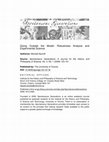
Spontaneous Generations: A Journal for The History and Philosophy of Science, 2010
In 1966 the population biologist Richard Levins gave a forceful and influential defence of a meth... more In 1966 the population biologist Richard Levins gave a forceful and influential defence of a method called “robustness analysis” (RA). RA is a way of assessing the result of a model by showing that different but related models give the same result. As Levins put it, “our truth is the intersection of independent lies” (1966, 423). Steven Orzack and Elliott Sober (1993) responded with an equally forceful critique of this method, concluding that the idea of robustness “lacks proper definition and that its bearing on the question of whether a proposition is true is highly problematic” (533). Replies to Orzack and Sober, from Levins (1993) and Weisberg (2006b), have rejected the idea that RA, on its own, can confirm the results of models. I argue that these replies have not properly addressed Orzack and Sober’s real criticisms, which focus not on the role of empirical data in RA but on the problem of ensuring that the models used in RA are independent. By drawing on accounts of RA in experimental science, I argue that there is in fact a fallible but viable form of RA that can both confirm the results of models and incorporate empirical data. However, for reasons other than those of Orzack and Sober, I conclude that RA may be of limited use in model-based science, as the example of fishery biology can show.

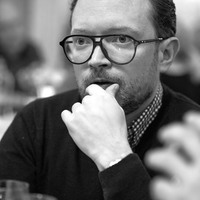



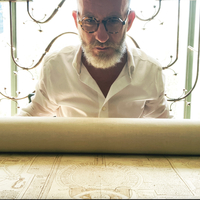

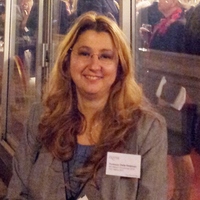


Uploads
PhD Dissertation by Michael Bycroft
Selected talks by Michael Bycroft
Papers by Michael Bycroft
Les recherches de Dutour sur l'électricité se déroulèrent en trois phases. En 1744 il commença sur ce phénomène des expériences qu'il raconta de temps en temps dans ses lettres à Nollet. La deuxième phase consiste en deux papiers parus en 1750 et 1755 résumant ses recherches des années 1740 et y ajoutant quelques nouvelles expériences; dans ses mémoires Dutour fit parfois usage du système Nollet, dont il avait appris les détails par une lettre de son auteur en 1745. Un troisième mémoire de 1755 marque le début de la dernière phase qui allait durer jusqu'à la mort de Nollet en 1770. Pendant cette période, et surtout entre 1755 et 1760, Dutour s'allia avec Nollet pour défendre son système contre Franklin et les autres partisans de “l'électricité en moins.”
Les recherches de Dutour sur l'électricité se déroulèrent en trois phases. En 1744 il commença sur ce phénomène des expériences qu'il raconta de temps en temps dans ses lettres à Nollet. La deuxième phase consiste en deux papiers parus en 1750 et 1755 résumant ses recherches des années 1740 et y ajoutant quelques nouvelles expériences; dans ses mémoires Dutour fit parfois usage du système Nollet, dont il avait appris les détails par une lettre de son auteur en 1745. Un troisième mémoire de 1755 marque le début de la dernière phase qui allait durer jusqu'à la mort de Nollet en 1770. Pendant cette période, et surtout entre 1755 et 1760, Dutour s'allia avec Nollet pour défendre son système contre Franklin et les autres partisans de “l'électricité en moins.”
The worksheets for assessing the energy needs of the stations as well as cost-effectiveness of different energy sources are available for download.
245 pages.